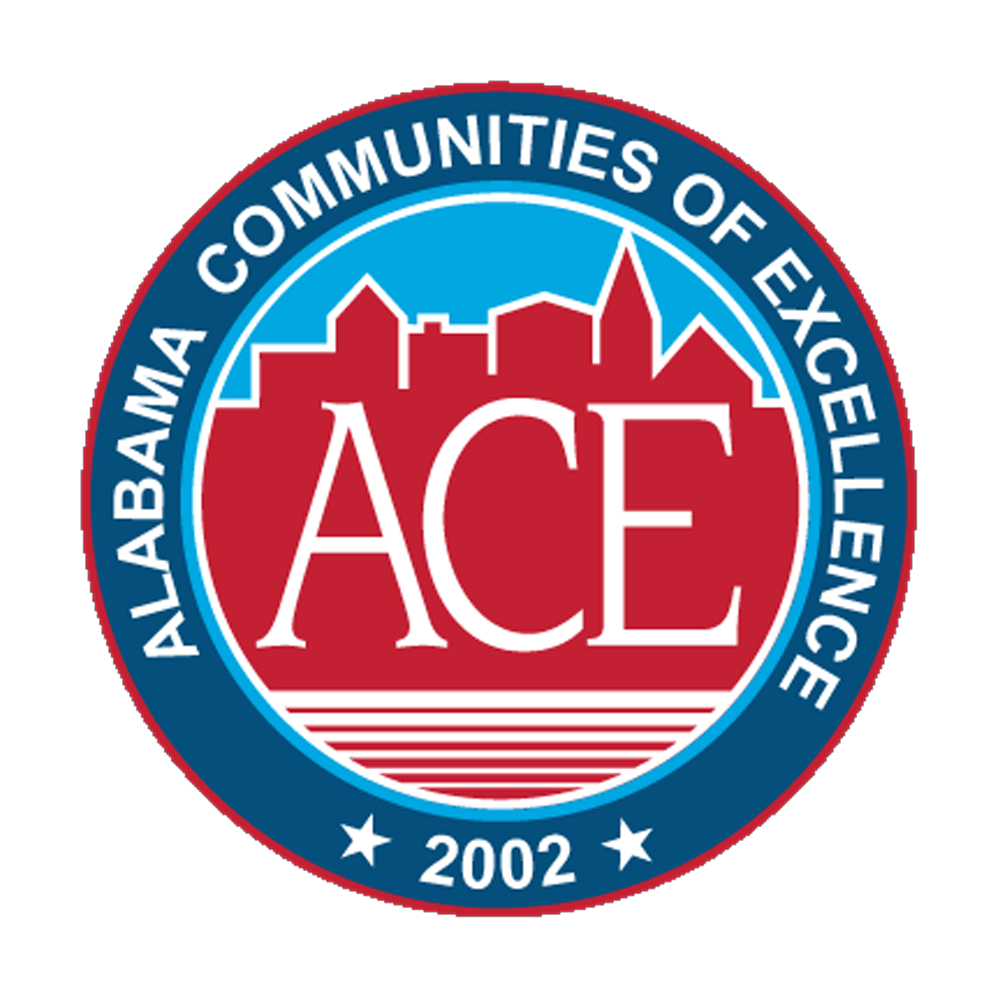The Alabama Communities of Excellence (ACE) program offers a systematic approach with the necessary technical resources and tools to help Alabama’s small cities promote growth and prosperity by focusing on their distinctive assets and resources. ACE understands the uniqueness of each community, recognizing that every city has different assets, values, concerns and priorities.
Established in 2002, Alabama Communities of Excellence (ACE) is a 501(c)(3) organization that provides technical assistance to select communities with populations ranging from 2,000 to 18,000 in an effort to strengthen long-term economic success. Through a comprehensive, three-phase approach, ACE uses the collective expertise of its partner organizations – ranging from state agencies and associations to banks, utilities, universities and others – to foster unique community development programs.
The ACE Team, comprised of technical discipline experts ranging from economic and industrial development to education, healthcare, historic preservation, leadership development, planning, tourism and community development, assists each participating city with developing a vision based on its own unique sensibilities and assets. At its core, ACE principles include the active involvement by community stakeholders across a broad demographic spectrum coupled with development of local leaders and leadership capacity and an emphasis on the importance of developing and implementing short and long-term plans to further the realization of the municipality’s vision. In addition to technical assistance, an Alabama Community of Excellence designation is given to each city that completes the three-phase program.
Communities interested in participating in the ACE program must apply for consideration. Candidates for the ACE program are selected using a competitive application process. At the beginning of each selection process, applications are disseminated to the mayors of those communities having the qualifying population of 2,000 to 18,000.
The main criteria used in selecting ACE participants are: 1) the level of commitment to the ACE program; 2) the community’s capacity to support the ACE program, and 3) the provision of complete and accurate information in the application. ACE also strives to achieve widespread geographic coverage across Alabama.
Once a community has been accepted into the ACE program, it must identify a local ACE coordinator. This local coordinator will not only spearhead ACE efforts locally, but will also serve as the liaison between ACE and the community. The ACE process begins with Phase I, known as the assessment phase.
Phase I – Assessment
During Phase I of the ACE program, an ACE Team comprised of experts across a range of topics, visits the community to develop a comprehensive “report card” detailing community assets and recommending possible strategies. Prior to the visit, a self-assessment survey is sent to members of the local community to gather their impressions. The Assessment Visit also includes a public, open-forum community meeting where residents receive an overview explanation of the ACE process; the results of the self-assessment survey are presented; and stakeholders are asked to share their perspectives and opinions about the community with each other and with the ACE Team.
Based on the information and impressions received during the Assessment Visit, the ACE Team prepares an Assessment Report summarizing the Team’s findings and impressions and outlining several recommendations for the municipality’s consideration. This Assessment Report is presented to the community, typically at a City Council meeting. After receiving this Assessment Report, the municipality is invited to move into Phase II.
Phase II – Leadership Development and Strategic Planning
With the guidance of a skilled ACE facilitator, the municipality develops a formal vision statement and strategic plan during Phase II that includes goal statements and strategies to achieve those goals, as well as action items for implementing the strategies. Although the planning horizon for a strategic plan is typically three to five years, the plan should be reviewed and updated at least annually. The ACE Team is available to advise each participating city’s strategic plan committee on selecting effective strategies and locating resources needed for implementing the plan.
Establishment of a formal, active leadership development program is a key requirement for communities during Phase II of the ACE program. If the city does not have a leadership program, the ACE Team will provide consultation and assistance to establish a leadership program that meets ACE standards. Leadership development programs are the key to building a core nucleus of citizens whose awareness of current issues, knowledge of the community, leadership skill sets and experience working with one another prepare them to step forward and assume leadership roles in the community. If the participating community has an existing leadership program, an ACE leadership specialist will determine if it meets the ACE standards. If the current leadership program does not fulfill ACE requirements, the leadership specialist will make recommendations that will enable the community to enhance the existing program to satisfy ACE requirements.
Another aspect of Phase II is the designation or creation of a nonprofit development organization representing public and private interests that can seek funding community development initiatives. If the town does not already have a suitable nonprofit organization in place, ACE directs the town toward resources that can assist in the establishment of a nonprofit development organization. There are several advantages to having an organization that is deemed to be a tax-exempt charity under IRS code section 501(c)(3), including enabling contributions to be treated as tax deductible charitable donations.
Phase III – Implementation and Comprehensive Planning
During Phase III, the community works on implementing the strategic plan that was developed during Phase II, and begins developing a comprehensive plan. While the strategic plan is relatively short-term, usually covering a three-to-five-year period, and is updated at least annually, a comprehensive plan provides a long-term guide for the community to develop its infrastructure and other community facilities, promote good design principles, and maximize its physical features and assets are for future growth and development. The planning horizon for a comprehensive plan is typically 10 to 20 years, and is only updated every five years. The strategic plan and comprehensive plan should work together to help the community achieve its vision. To complete Phase III of the ACE program, the community should have in place both a planning process and a targeted implementation plan.
Certification as an Alabama Community of Excellence
When an ACE candidate community successfully completes all three Phases of the ACE program, it will be declared to be an Alabama Community of Excellence. Graduating communities are recognized in May of each year at the Alabama League of Municipalities Annual Convention. The timeframe for completion of the ACE program varies from community to community; however, communities are encouraged to successfully complete the program within three years.
Recertification
To maintain the Alabama Community of Excellence designation, a community must be recertified within three to five years following its original designation. Recertification is based on the ACE Community’s progress in implementing its plans and its progress towards approaching ACE Community Standards as stated in Definition of an ACE Community.

